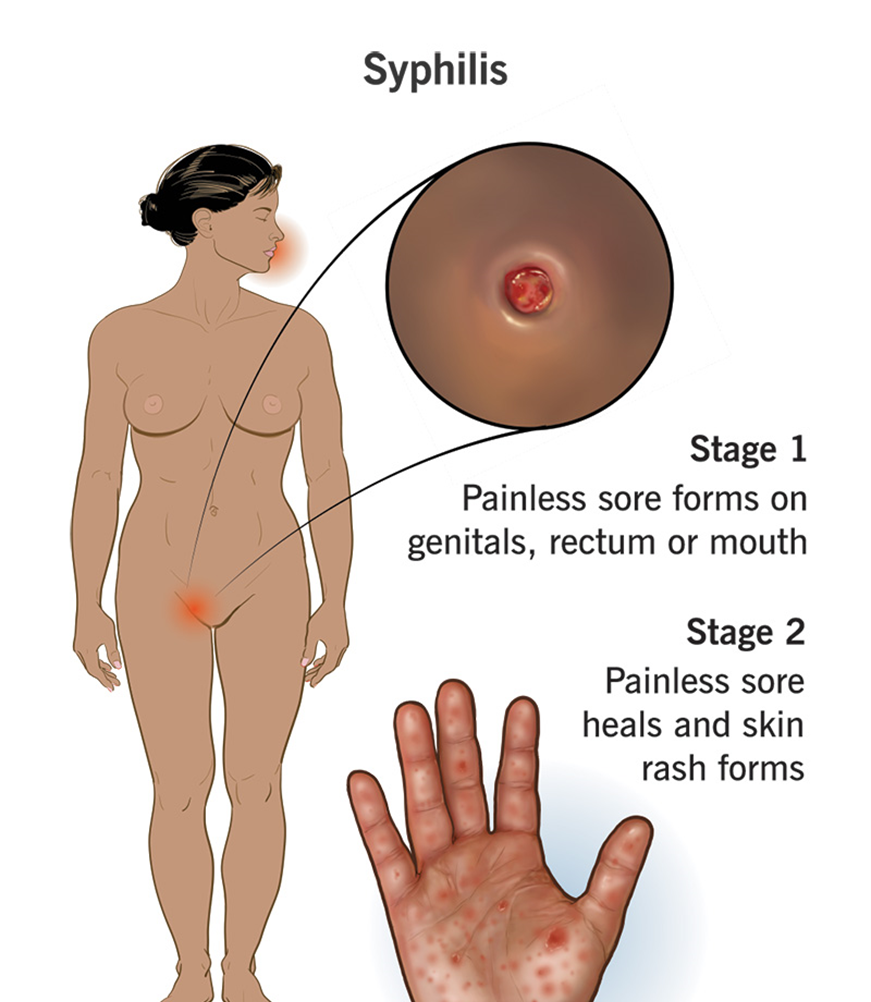Which of the following is a bacterial infection that spreads through any form of unprotected sex and by skin contact? Typically, it has stages of increasingly serious symptoms. If untreated, it may affect the heart, eyes, and brain. It can be treated with antibiotics.
Gonorrhea
Syphilis
Chlamydia
Trichomoniasis
The Correct Answer is B
Choice A reason: Gonorrhea is incorrect because it is not the infection described in the question. It is a bacterial infection that spreads through any form of unprotected sex, but it does not have stages of symptoms or affect the heart, eyes, and brain. It can cause pain, discharge, and inflammation in the genitals, anus, or throat. It can be treated with antibiotics.
Choice B reason: Syphilis is correct because it is the infection described in the question. It is a bacterial infection that spreads through any form of unprotected sex and by skin contact. It has stages of symptoms, such as sores, rashes, fever, and fatigue. If untreated, it can affect the heart, eyes, and brain, causing serious complications. It can be treated with antibiotics.
Choice C reason: Chlamydia is incorrect because it is not the infection described in the question. It is a bacterial infection that spreads through any form of unprotected sex, but it does not have stages of symptoms or affect the heart, eyes, and brain. It often causes no symptoms, but it can cause pain, discharge, and bleeding in the genitals or rectum. It can be treated with antibiotics.
Choice D reason: Trichomoniasis is incorrect because it is not the infection described in the question. It is a parasitic infection that spreads through any form of unprotected sex, but it does not have stages of symptoms or affect the heart, eyes, and brain. It can cause itching, burning, and odor in the genitals. It can be treated with antiparasitic drugs.

Nursing Test Bank
Naxlex Comprehensive Predictor Exams
Related Questions
Correct Answer is C
Explanation
Choice A reason: Taking the medication between meals will help you avoid becoming constipated is incorrect because it is not the reason why the provider instructed that she take the ferrous sulfate between meals. It is a possible benefit of taking the medication between meals, but it is not the main purpose. Iron supplements can cause constipation, but this can be prevented by drinking plenty of fluids, eating high-fiber foods, and exercising regularly.
Choice B reason: The medication can cause nausea if taken with food is incorrect because it is not the reason why the provider instructed that she take the ferrous sulfate between meals. It is a possible side effect of taking the medication with or without food, but it is not the main reason. Iron supplements can cause nausea, but this can be reduced by taking the medication with a small amount of food, such as crackers, or by taking an antiemetic medication.
Choice C reason: Taking the medication between meals will help you absorb the medication more efficiently is correct because it is the reason why the provider instructed that she take the ferrous sulfate between meals. It is the main purpose of taking the medication between meals, as iron absorption is enhanced when the stomach is empty and the pH is low. Iron supplements can interact with food components, such as calcium, phytates, and tannins, and reduce the amount of iron that is absorbed by the body.
Choice D reason: Taking the medication with food increases the risk of esophagitis is incorrect because it is not the reason why the provider instructed that she take the ferrous sulfate between meals. It is a possible complication of taking the medication without enough water, but it is not the main reason. Iron supplements can cause esophagitis, which is inflammation of the esophagus, if they are not swallowed properly or if they get stuck in the throat. This can be prevented by taking the medication with a full glass of water, sitting upright, and not lying down for at least 30 minutes after taking the medication.
Correct Answer is A
Explanation
Choice A reason: Insulin is the preferred medication for gestational diabetes mellitus, as it does not cross the placenta and has no adverse effects on the fetus. It can be administered subcutaneously or intravenously, depending on the blood glucose level and the type of insulin.
Choice B reason: Glipizide is an oral antidiabetic agent that belongs to the sulfonylurea class. It stimulates the pancreas to secrete more insulin and lowers the blood glucose level. However, it is not recommended for gestational diabetes mellitus, as it can cross the placenta and cause hypoglycemia, macrosomia, or teratogenic effects on the fetus.
Choice C reason: Acarbose is an oral antidiabetic agent that belongs to the alpha-glucosidase inhibitor class. It delays the absorption of carbohydrates from the intestine and reduces the postprandial blood glucose level. However, it is not recommended for gestational diabetes mellitus, as it can cause gastrointestinal side effects, such as flatulence, diarrhea, or abdominal pain, and may interfere with the absorption of other nutrients.
Choice D reason: Repaglinide is an oral antidiabetic agent that belongs to the meglitinide class. It stimulates the pancreas to secrete more insulin and lowers the blood glucose level. However, it is not recommended for gestational diabetes mellitus, as it can cross the placenta and cause hypoglycemia, macrosomia, or teratogenic effects on the fetus.
Whether you are a student looking to ace your exams or a practicing nurse seeking to enhance your expertise , our nursing education contents will empower you with the confidence and competence to make a difference in the lives of patients and become a respected leader in the healthcare field.
Visit Naxlex, invest in your future and unlock endless possibilities with our unparalleled nursing education contents today
Report Wrong Answer on the Current Question
Do you disagree with the answer? If yes, what is your expected answer? Explain.
Kindly be descriptive with the issue you are facing.
